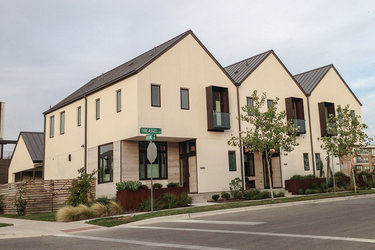Update Committee mulls proposals to increase affordable housing in town
GUILDERLAND — The committee that worked on updating Guilderland’s 21-year-old comprehensive plan got a first chance to discuss the publicly released second draft on July 24.
Housing was central to the discussion as the draft recommends a streamlined process for approving multi-family housing, establishing pre-approved plans, and allowing accessory dwelling units among other changes.
While the first draft, released in March, was not made public, the second draft was released to the public on July 16 .
Comprehensive plans provide “the backbone for the local zoning law,” according to New York State law. A municipality’s zoning laws are required to “be adopted in accordance with a comprehensive plan,” which itself “is the culmination of a planning process that establishes the official land use policy of a community and presents goals and a vision for the future that guides official decision-making.”
Supervisor Peter Barber has said he hopes that, after a series of public hearings, the updated plan, in the works for two years, will be adopted by the town board before the end of the year.
Housing proposals
As of the 2020 federal census, Guilderland had approximately 16,000 housing units, about 15,000 of which were occupied. Between 2010 and 2020, the draft plan states, “fewer than 1,000 housing units were added to the housing supply, the smallest increase in decades. By contrast, the Town gained 2,301 housing units during the 1980s and 1,814 during the 1990s.”
Among the steps discussed and/or offered in the plan to increase housing — not just housing, but specific types of housing like senior and affordable — and/or streamline the approval process were:
— Allowing multi-family housing as a use-by-right in more zoning districts, rather than the current and more lengthy legislative planned unit development (PUD) process;
— Expanding allowable housing types other than single-family “in appropriate districts”;
— Offering density bonuses or other incentives to developers who include certain types housing units in their projects;
— Establishing pre-approved plans or templates for certain types of housing developments to expedite the review process;
— Having a planning department staffer or the planning board itself work directly with developers to find grants for certain types of housing projects;
— Updating zoning to require major subdivisions and large developments to incorporate affordable housing;
— Developing policies for accessory dwelling units “as an opportunity for alternative housing options in single-family residential neighborhoods while preserving the character of these neighborhoods”;
— Adding a requirement for affordable residential units in planned unit developments; and
— Using density restrictions rather than minimum lot sizes in certain residential districts “along with the provision for density bonuses that incentivize affordable housing types, open space protection, and other desired amenities.”
Pro-housing certification
Town Planner Kenneth Kovalchik kicked off the housing discussion by explaining Guilderland’s new pro-housing community designation and what it could mean for housing in town.
The designation essentially increases the chances of participating municipalities to receive state funds.
To achieve this designation, Kovalchik said, the town had to provide extensive information to the state, like detailed information about each zoning district, what is allowed and restricted in each district, and Guilderland’s development history from 2018 to 2022.
He said the town had certain criteria for the number of new housing units built during that time — either that Guilderland’s housing stock had increased by 0.33 percent in the last year or by 1 percent over the previous three years.
Kovalchik told committee members that, over the last few years, there had been several projects proposed in town, including an affordable senior project on New Karner Road and an intergenerational community project on Mercy Care Lane.
“Both of those projects were reliant upon grant funds,” Kovalchik said.
Kovalchik said both applicants had applied for grant funding from the state but were denied twice, even though a market study concluded there was strong demand for affordable senior housing in Guilderland.
Given the competitive nature of grant funding, Kovalchik said he hoped that, by receiving the designation, future town-approved projects might have a better chance of being awarded state funds.
MR zoning
One way to increase housing, Kovalchik told committee members, was to expand certain types of zoning.
He said that properties with the multiple residence (MR) zoning classification make up only 1 percent of the landmass in town. “So you have 1 percent of the land mass in town that’s zoned for allowing apartments,” Kovalchik said. “That’s important because … it’s a use allowed by right,” which means a proposal can be processed as a site plan application through the planning board.
“What we’re seeing now,” he said, “because we have such a lack of zoning to allow multifamily, is most of those applications are processed as a PUD now, which is a very long and lengthy process.”
Kovalchik said, “You’re dealing with both the town board and the planning board. It is a legislative approval versus a use-by-right and that’s a significant difference because a municipality could come up with any reason they wanted to deny.”
Committee member Dominic Rigosu wanted to know if streamlining the approval process — which would mean changing the code — would be for all types of multi-family housing, because it could lead to Guilderland seeing a lot more market-rate apartment proposals, rather than the more-needed senior or affordable housing.
“If I’m a developer, I see a vacant piece of land and I’ve got to do a PUD or if you’re going to rezone and increase the MR zone, I’m going to look at this and say, ‘I’m just going to [do] market-rate apartments … There’s no incentive to do anything else besides that.’”
Rigosu, who was on the housing subcommittee that helped make specific recommendations, said, “From my point on the committee, that wasn’t the goal.”
Kovalchik said he didn’t know if requiring a percentage of housing units in a proposed project to be workforce or affordable housing was streamlining the process, but, as the committee’s consultant, Jaclyn Hakes, noted, requiring a percentage of a specific type of housing to be set aside in a project was a recommendation in the plan, illustrating how very in-the-weeds the conversation was becoming.
Committee member Elizabeth Lott, who also chair’s the town’s zoning board, said the housing set-aside would make “clear what the criteria are,” and avoid “having only applicants coming before you … that are going to try to maximize their profit.”
Kovalchik said the town had to “start thinking out of the box,” it “can’t just require affordable housing as your only means to address the housing issue.”
He said the affordability requirement was “one way” to expand housing in town, adding “I’m more all of the above.” For example, he said, “Our single-family district only allows single-family homes; we need to start thinking whether duplexes [or] triplexes should be allowed [or if] accessory dwelling units should be allowed as a use-by-right.”
Lott asked how the town could attract more projects like the two that didn’t receive state funding.
“In the future, if they come before us, how can we help them get the grants?” she asked. “How can we figure out a way — is it a timeline thing? Was it a money thing? Was it the zoning code itself? I mean, what was it that was a roadblock? Or there were just too many applicants?”
Kovalchik said to Lott that he was told “informally,” while also noting the information was a year or two old and that things may have changed, that the state was focusing its affordable-housing funding on New York’s “urban environments” rather than its “suburban communities.”
Lott wondered how communities like Guilderland could change that dynamic. “I mean, if we’re always running against an urban competitor, we’re always going to lose, right?” she asked.
Kovalchik told Lott, “If I was debating the state right now,” he’d provide it with census data showing that “easily 30 percent” of Guilderland is “considered an urban environment.”
He said, “I would make an argument that you cannot consider [Guilderland] suburban when the Census Bureau considers this part of our town to be urban.”
Recommendations
Hakes, the consultant, sought to take the conversation and turn it into specific recommendations, starting with one from Lott that the planning department assist developers interested in providing affordable or senior housing with the state grant process.
“The second piece,” Hakes said, referring to streamlining the approval process for MR housing, “that is a little more challenging piece.”
What Hakes recommended was acknowledging that streamlining was a goal in general, but asking that a focus be placed on specific types of housing, like senior and affordable.
But streamlining the MR approval process, Kovalchik noted earlier in the meeting, is moot unless the state does something about its own environmental review process.
“The whole streamlining thing,” he said, “the caveat to that is: Unless the state wants to do a major overhaul to the SEQR [State Environmental Quality Review Act] regulations, you’re going have a hard time streamlining the land-use review process in the state of New York.
“So that’s the reality: SEQR is what makes land-use approval very expensive, very time consuming. So unless that is changed — and I’m not seeing anything being proposed by the state to change that — you can only streamline so much.”


